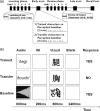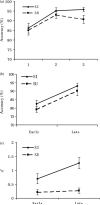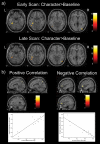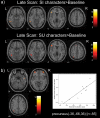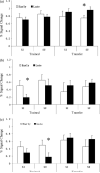Item-specific and generalization effects on brain activation when learning Chinese characters - PubMed (original) (raw)
Comparative Study
Item-specific and generalization effects on brain activation when learning Chinese characters
Yuan Deng et al. Neuropsychologia. 2008.
Abstract
Neural changes related to learning of the meaning of Chinese characters in English speakers were examined using functional magnetic resonance imaging (fMRI). We examined item specific learning effects for trained characters, but also the generalization of semantic knowledge to novel transfer characters that shared a semantic radical (part of a character that gives a clue to word meaning, e.g. water for lake) with trained characters. Behavioral results show that acquired semantic knowledge improves performance for both trained and transfer characters. Neuroimaging results show that the left fusiform gyrus plays a central role in the visual processing of orthographic information in characters. The left superior parietal cortex seems to play a crucial role in learning the visual-spatial aspects of the characters because it shows learning related decreases for trained characters, is correlated with behavioral improvement from early to late in learning for the trained characters, and is correlated with better long-term retention for the transfer characters. The inferior frontal gyrus seems to be associated with the efficiency of retrieving and manipulating semantic representations because there are learning related decreases for trained characters and this decrease is correlated with greater behavioral improvement from early to late in learning.
Figures
Fig. 1
Examples of stimuli with their English translation and their pronunciation in pinyin. Numbers for the pinyin indicate one of four tones: (a) semantic-implied type characters, the left part of each character (semantic radical) indicates “body part”; (b) semantic-unrelated type characters, the left part of each character indicates different meanings, while the right part (phonetic radical) of each character is the same; (c) two examples of visual stimulus for the baseline task in the fMRI scan with the left part or right part of the symbol bolded.
Fig. 2
(a) Illustration of overall training procedure; (b) illustration of experiment tasks in the fMRI session.
Fig. 3
Behavioral results. (a) Mean accuracy (bars indicate 1 standard error) for the quizzes for SI and SU character types: (1) collapsed data from all quizzes in the learning phase, (2) collapsed data from the first two quizzes in review phase, and (3) collapsed data from the third and fourth quizzes in review phase. (b) Mean accuracy (bars indicate 1 standard error) for trained characters in the early and late fMRI session. (c) Mean d′ (bars indicate 1 standard error) for transfer characters in the early and late fMRI session. SI, semantic-implied; SU, semantic-unrelated.
Fig. 4
(a) Brain activation maps for the semantic matching task (collapsed across SI and SU types) relative to a perceptual baseline for the trained characters in the early and late scan sessions. (b) Brain regions that showed greater activation for trained characters from early to late in learning that were positively (superior parietal lobule) and negatively (inferior frontal gyrus) correlated with greater accuracy improvement from early to late in learning.
Fig. 5
(a) Brain activation maps for the semantic matching task relative to a perceptual baseline for the transfer characters for SI and SU types in the late scan session. (b) Brain regions that showed greater activation for transfer characters from early to late in learning that were positively correlated with higher recognition rate of radicals in a delayed test given 3–6 months after training. Please note that only 10 of the 12 subjects were available for the delayed testing.
Fig. 6
Percentage signal change for SI and SU types on both trained and transfer characters in three ROIs: (a) fusiform gyrus, (b) superior parietal lobule, and (c) inferior frontal gyrus. Asterisks indicates a significant difference from early to late in training (_t_-test p < 0.05).
Similar articles
- The involvement of occipital and inferior frontal cortex in the phonological learning of Chinese characters.
Deng Y, Chou TL, Ding GS, Peng DL, Booth JR. Deng Y, et al. J Cogn Neurosci. 2011 Aug;23(8):1998-2012. doi: 10.1162/jocn.2010.21571. Epub 2010 Aug 31. J Cogn Neurosci. 2011. PMID: 20807053 Free PMC article. - Language experience shapes fusiform activation when processing a logographic artificial language: an fMRI training study.
Xue G, Chen C, Jin Z, Dong Q. Xue G, et al. Neuroimage. 2006 Jul 1;31(3):1315-26. doi: 10.1016/j.neuroimage.2005.11.055. Epub 2006 Apr 27. Neuroimage. 2006. PMID: 16644241 - Comparison of brain mechanisms underlying the processing of Chinese characters and pseudo-characters: an event-related potential study.
Wang T, Li H, Zhang Q, Tu S, Yu C, Qiu J. Wang T, et al. Int J Psychol. 2010 Apr 1;45(2):102-10. doi: 10.1080/00207590903156439. Int J Psychol. 2010. PMID: 22043890 - A meta-analysis of fMRI studies on Chinese orthographic, phonological, and semantic processing.
Wu CY, Ho MH, Chen SH. Wu CY, et al. Neuroimage. 2012 Oct 15;63(1):381-91. doi: 10.1016/j.neuroimage.2012.06.047. Epub 2012 Jul 1. Neuroimage. 2012. PMID: 22759996 Review. - Functional MRI of language: new approaches to understanding the cortical organization of semantic processing.
Bookheimer S. Bookheimer S. Annu Rev Neurosci. 2002;25:151-88. doi: 10.1146/annurev.neuro.25.112701.142946. Epub 2002 Mar 19. Annu Rev Neurosci. 2002. PMID: 12052907 Review.
Cited by
- Unimodal and multimodal regions for logographic language processing in left ventral occipitotemporal cortex.
Deng Y, Wu Q, Weng X. Deng Y, et al. Front Hum Neurosci. 2013 Sep 27;7:619. doi: 10.3389/fnhum.2013.00619. eCollection 2013. Front Hum Neurosci. 2013. PMID: 24098280 Free PMC article. - Spontaneous brain activity predicts learning ability of foreign sounds.
Ventura-Campos N, Sanjuán A, González J, Palomar-García MÁ, Rodríguez-Pujadas A, Sebastián-Gallés N, Deco G, Ávila C. Ventura-Campos N, et al. J Neurosci. 2013 May 29;33(22):9295-305. doi: 10.1523/JNEUROSCI.4655-12.2013. J Neurosci. 2013. PMID: 23719798 Free PMC article. - Category-Biased Neural Representations Form Spontaneously during Learning That Emphasizes Memory for Specific Instances.
Ashby SR, Zeithamova D. Ashby SR, et al. J Neurosci. 2022 Feb 2;42(5):865-876. doi: 10.1523/JNEUROSCI.1396-21.2021. Epub 2021 Dec 22. J Neurosci. 2022. PMID: 34937702 Free PMC article. - Cognitive remediation in schizophrenia.
Medalia A, Choi J. Medalia A, et al. Neuropsychol Rev. 2009 Sep;19(3):353-64. doi: 10.1007/s11065-009-9097-y. Epub 2009 May 15. Neuropsychol Rev. 2009. PMID: 19444614 Review. - Can we measure memes?
McNamara A. McNamara A. Front Evol Neurosci. 2011 May 25;3:1. doi: 10.3389/fnevo.2011.00001. eCollection 2011. Front Evol Neurosci. 2011. PMID: 21720531 Free PMC article.
References
- Baayen RH, Piepenbrock R, Gulikers L. The CELEX lexical database (version release 2) [CD-ROM] Linguistic Data Consortium, University of Pennsylvania; Philadelphia: 1995.
- Booth JR, Burman DD, Meyer JR, Gitelman DR, Parrish TB, Mesulam MM. Functional anatomy of intra- and cross-modal lexical tasks. Neuroimage. 2002a;16:7–22. - PubMed
Publication types
MeSH terms
Grants and funding
- R56 HD042049/HD/NICHD NIH HHS/United States
- R01 HD042049/HD/NICHD NIH HHS/United States
- R21 DC006149/DC/NIDCD NIH HHS/United States
- HD042049/HD/NICHD NIH HHS/United States
- DC06149/DC/NIDCD NIH HHS/United States
LinkOut - more resources
Full Text Sources

